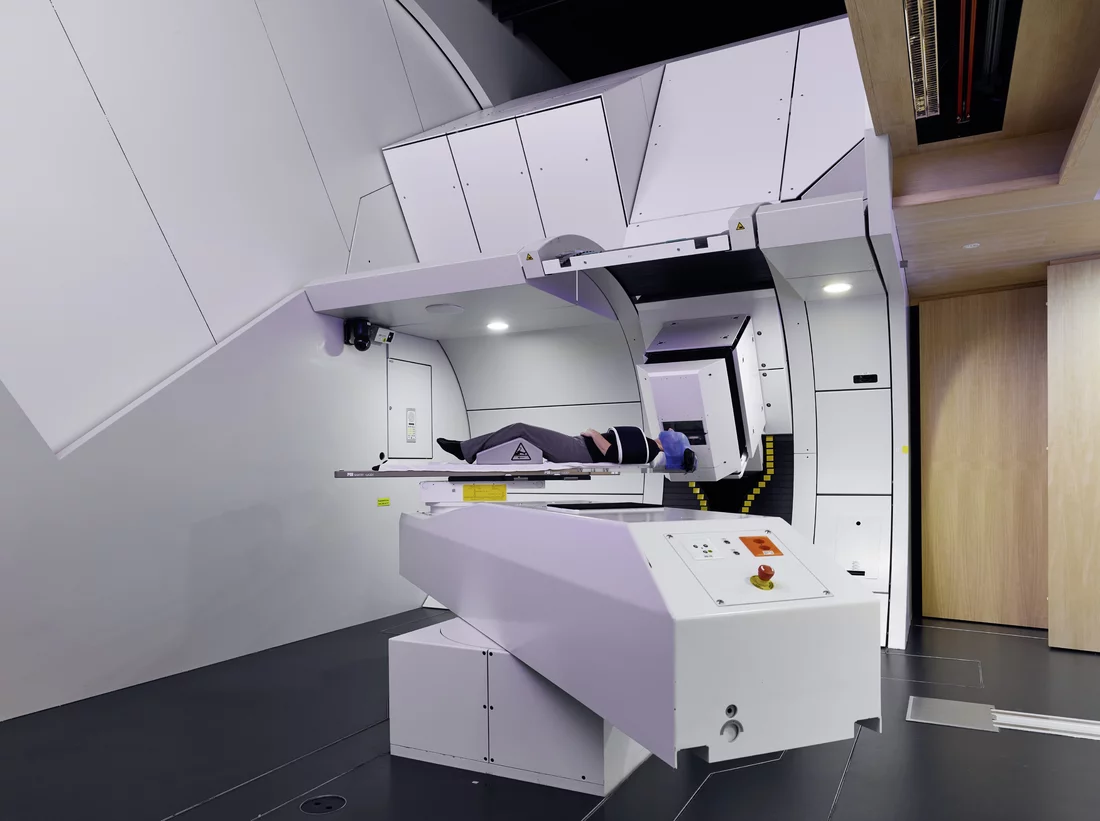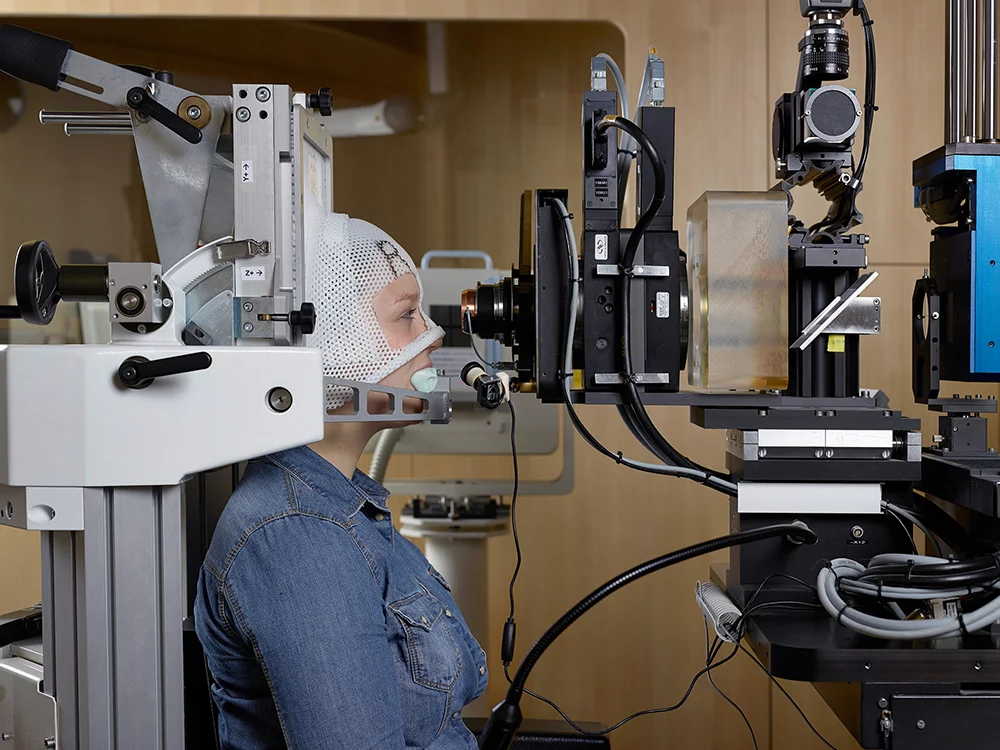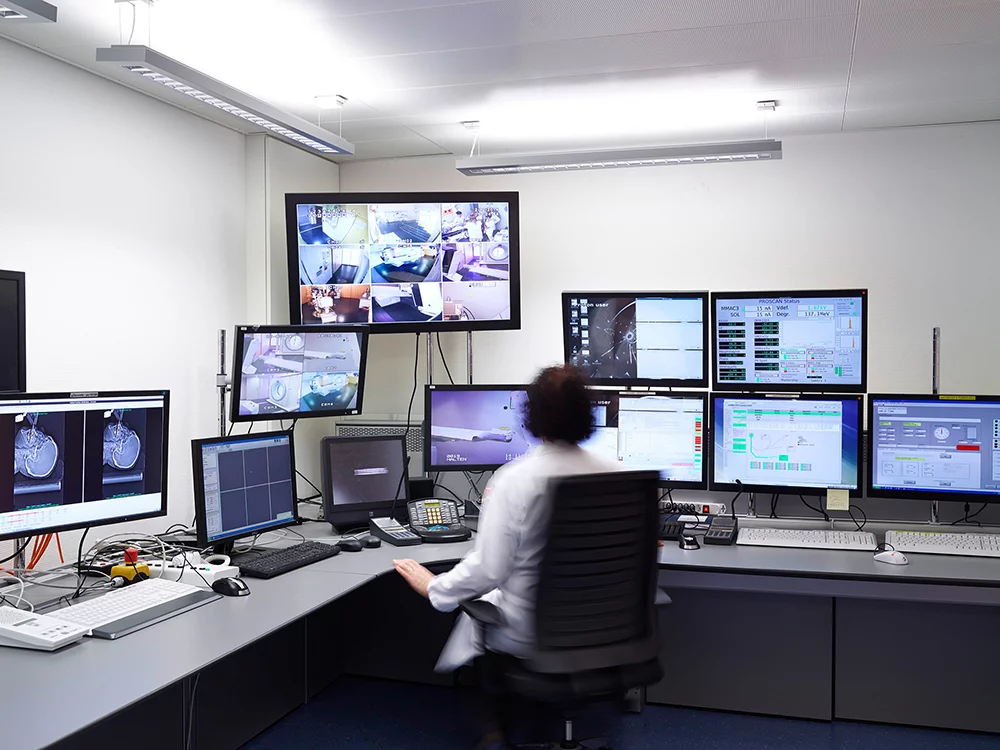For more than 30 years, cancer patients have been coming to the small locality of Villigen on the Aare River. There, at the Paul Scherrer Institute PSI, right next to the large-scale research facilities, they receive a treatment that is unique in Switzerland: proton therapy. This state-of-the-art form of radiation therapy against cancer has major advantages compared to conventional irradiation in terms of effectiveness and side-effects. Proton therapy allows doctors to treat a tumour much more precisely, and consequently with a more effective radiation dose, than they otherwise could, without harming the surrounding healthy tissue. Thus they can even destroy tumours in hard-to-reach places in the body or in close proximity to radiation-sensitive organs. For this special treatment, the PSI has its own Center for Proton Therapy. Its pioneering work has not only helped several thousand patients, but also has fundamentally changed proton therapy worldwide.
Anyone who thinks that everything at the Paul Scherrer Institute PSI revolves around research alone will be disabused in the Center for Proton Therapy CPT. Here the focus is on the patient. In the modern, bright building right next to PSI’s synchrotron light source, there are doctors’ rooms, a waiting area, and preparation and examination rooms. Here too, as in a radiological clinic, stand large medical devices such as computer tomography and magnetic resonance tomography scanners with which cross-sectional images of the patient’s body are taken. With the help of these images, doctors can locate a tumour inside the patient with millimetre accuracy, to prepare a custom-tailored treatment plan. Three treatment sites are available at the CPT for proton irradiation of tumour patients, and another joins them this year. Because the results of proton therapy are very promising, the demand for this kind of irradiation has greatly increased in recent years
, explains Damien Weber, head and chairman of the CPT. We have to be prepared.
They are in a good starting position, since proton therapy has a long tradition at the PSI. Cancer patients have been treated here with proton therapy since the 1980s. On top of that, PSI researchers have developed a new technique for proton irradiation that is even more effective and more gentle than earlier forms of proton therapy.
But why, of all things, protons? Weber explains: Protons have several advantages in comparison to the otherwise routine cancer irradiation with photons. One can precisely control to what depth in the body they should penetrate. They exert their greatest effect there. On their way, protons cause practically no damage in the tissue, and everything behind that point remains intact.
The largest number of patients on earth
In everyday life, protons are everywhere: As a fundamental building block of atoms, they are found in every element and in every object around us. For their high prevalence, though, they get relatively little attention. The elementary particles are favourites only for physicists, for decades now. Thus more than 40 years ago, at what is now the PSI, an accelerator facility was built to generate proton beams for physics experiments. From the beginning of the 1980s, researchers wanted to probe the potential of the particles where conventional techniques failed: in the treatment of ocular tumours. With the launch of the treatment station OPTIS 1 in 1984, the foundation was laid for proton therapy in Switzerland. Here, for the first time, tiny tumours on the ocular fundus at the back of the eyeball could be irradiated without endangering other structures of the eye. And better still: While previously most patients had to have the affected eye removed because of the carcinoma, from then on the eye could be saved in more than 90 percent of cases (although restoring vision to that eye is not necessarily possible). Already 6,700 patients with ocular tumours have been treated here since 1984, more than anywhere else on earth. After 26 years in use, the old OPTIS 1 equipment was replaced by a new facility: OPTIS 2. Although the treatment principle remains the same in the more up-to-date OPTIS 2 facility, the new device works more reliably and more safely.
Destroying deep-seated tumours
Proton therapy at the PSI also helps other patients suffering from cancer. Next to the treatment station OPTIS 2, there are also two so-called gantries — huge pivot-mounted irradiation devices with which tumours inside the body can be irradiated. The first gantry was developed 20 years ago here at the PSI. At that time, roughly a decade after the launch of OPTIS 1, PSI researchers sparked a small revolution in proton therapy. They wanted to do more than just direct a fan-shaped proton beam at a tumour. Their goal was to encompass a tumour in its entire depth and often irregular form, and to sweep it evenly with a fine beam so that the whole volume would be hit. They achieved this 20 years ago with the development of the spot-scanning technique: On 25.11.1996, the first patient worldwide was treated with the new technique at the CPT. Since then, the spot-scanning technique has become a worldwide standard and has largely replaced the conventional passive scattering technique. Even children receive this therapy at the CPT, because they can tolerate only a weak dose of radiation, which was guaranteed for the first time by the spot-scanning technique. Its most important application is the treatment of deep-seated tumours and carcinomas that lie close to especially sensitive structures. Brain tumours, cancers in the ear-nose-and-throat area, and carcinomas close to the spinal cord are the most frequent application areas. Precisely there, accuracy is required that only a sufficiently thin proton beam can deliver — the beam at the PSI has a thickness of only 5 to 7 millimetres.
A stable beam of its own
Since 2007, the proton beams for the CPT are produced by the accelerator COMET, which was specially built for proton therapy. This is not connected with the large proton accelerator facility of the PSI that provides protons for experiments in physics and materials science. Thus the CPT became independent of the inspection-related interruptions that occur every year at the large proton accelerator facility. With COMET, Weber and his team have gained a continuous proton beam with which they can treat their patients year-round. Staff members of the CPT and the large-scale research facilities of the PSI work together to ensure that the facility and the three treatment stations function smoothly. Here we need many specialised experts
, Weber emphasises. At the CPT alone, more than 80 staff members are responsible that all patients are cared for in the best possible way. At OPTIS as well as the two gantries, nothing takes place without meticulous planning. Physicians, medical technical assistants, and medical physicists are responsible that the patients get exactly the right radiation dose at the right place in the body every time, and that organs and sensitive structures are protected. The patient office and a nurse shepherd the patients through the process, accompanying them personally and helping them deal with medical and organisational questions. They clarify whether or not insurance will cover the costs, how the patient will be transported, and where he or she will be accommodated. Physicists, engineers, technicians, and other specialists take care of the operational capability of the facilities and make sure the software and control systems run properly. Whenever a patient receives proton therapy, every detail is recorded in a so-called log file. All procedures are standardised and subject to a quality management system. In addition, treatment details for every patient are recorded in a data bank. This allows for later analysis of the same tumour types within the framework of observational studies. With the help of these data, Weber can also see how well proton therapy works long-term. The doctor is enthusiastic: It is a painless, non-invasive treatment that preserves the patient’s quality of life and enables a quick return to normal activities.
For Weber, it is no contradiction that his institution is located within one of the largest research facilities in Switzerland: The CPT profits from its connection with the PSI. With its long experience in the proton field, the PSI drives advances in physics and medical physics. So on the one hand we always have the most advanced technology, and on the other hand, we also work jointly to further develop proton therapy and to investigate new application areas.
In this, Weber and his team collaborate very closely with Swiss hospitals and universities. In addition, they provide advice for centres that want to operate new proton therapy facilities on their own. In international continuing-education sessions, PSI experts train specialists from all over the world in the areas of technology, physics, medicine, and medical physics. We are happy to pass on our knowledge
, Weber stresses, because in the end patients everywhere should receive the most up-to-date treatment.
Text: Sabine Goldhahn
Additional information
- The article Big help for small children describes how children suffering from cancer are treated with proton therapy at PSI’s center for proton therapy.
- A special form of proton therapy called spot-scanning technology was developed over twenty years ago at the PSI. This method is now used worldwide and has already helped several thousand patients. Details are provided in the article entitled 20 Years of high-precision combat against cancer.
- Proton therapy at the PSI started with the irradiation of ocular tumours. To date, the PSI itself has treated 6,700 patients. For more information, please see the article Rays of hope for patients.
- A whole team of specialists is responsible for proton therapy safety and quality standards at the PSI. For details please see Getting a handle on safety.
Contact
Prof. Dr. med. Damien Charles WeberHead and Chairman of the Center for Proton Therapy,
Paul Scherrer Institute, 5232 Villigen PSI, Switzerland
Telephone: +41 56 310 58 28, e-mail: damien.weber@psi.ch





